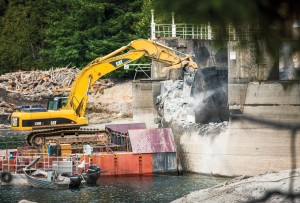Ex-federal official: Dams are ‘dinosaurs’

A barge-mounted excavator hammers away at Glines Canyon Dam in Washington, the largest dam removal in U.S. history. Photo/Ben Knight
By Anne Knowles
MINDEN — Dams and other surface storage are “dinosaurs.”
That’s according to Daniel P. Beard, the former commissioner of the U.S. Bureau of Reclamation, the government agency responsible for building and maintaining 475 dams across the country.
Beard spoke before and after a showing of the 90-minute documentary “Dam Nation” at the CVIC Hall here Oct. 21, hosted by University of Nevada Cooperative Extension and GreenACTnv, a local nonprofit promoting sustainable energy.
“They are the least effective way to deal with today’s problems,” according to Beard. “What we need to do is stop wasting water and promote water conservation and reuse. It is the cheapest, easiest solution to our water problem.”
Beard said Californians have already saved more water since Gov. Jerry Brown ordered cutbacks in April than would be produced by two proposed multibillion dollar dam projects in the Sacramento Valley and San Joaquin River Gorge.
“California conservation has demonstrated there is tremendous slack in the system,” Beard said.
He said we need to rethink the way water is priced in order to encourage conservation.
“We don’t hesitate to spend $3 for a half liter of water at the airport, yet somehow in our homes we expect we should get a lot of water and it should be cheap,” he said.
Beard also cited Australia where a 12-year drought forced the country to change its water law.
“Our water laws are irrational, first in time and use it or lose,” said Beard.
He said as a result water authorities such as the Southern Nevada Water Authority “circumvent” the law and buy up ranches and farms for the water rights.
SNWA spent $79 million to buy seven ranches in Southern Nevada a decade ago with the eventual goal of using the ranches’ groundwater to serve Las Vegas. The water authority grazes 11,000 sheep and cattle on the 960,000 acres.
Beard said he laughed when he read that the Nevada Legislature in the 2015 session could not pass a bill requiring vested water rights holders to prove their claims in an effort to inventory the state’s water supply.
Beard, who served as commissioner of the Bureau of Reclamation from 1993 to 1995, is the author of the recently published book “Deadbeat Dams,” in which he calls for the elimination of the Bureau of Reclamation and the removal of the Glen Canyon Dam.
The Glen Canyon Dam was built by USBR in the 1960s on the Colorado River in northern Arizona to provide water to the growing southwest. The dam filled the canyon to create Lake Powell and has been widely opposed ever since.
Beard said about 1,100 of the nation’s dams have been removed, mostly smaller ones. Larger dams cost millions to dismantle, such as Elwha Dam in Washington, the demolition of which is featured in the dam documentary.
Elwha Dam’s removal cost $350 million, said Beard.
Beard was the keynote speaker earlier Wednesday at a meeting of the Carson River Coalition in Carson City.




How do we store water without dams? Aren’t we drying up all the ground water from pumping it with wells? Typical bureauracrat answer is conserve and raise the rates, take more money from the public. Pay more for less is always their answer. I don’t want to pay more for less water I want to pay less for more.
I used to work for the “Dam People” & the policies of water storage were much different in the 70s. They knew droughts would come & ground water pumping was causing subsidence that could NEVER BE RECHARGED. Of course, they also mapped flood plains in the Central Valley & warned about paving over too much land which would result in flooding during times of heavy storms. I guess political correctness is taking over the need to survive.
Speaking as a recently retired water resources engineer with 35 years experience working with and for Central Valley Project ag water agencies it is important to keep Beard’s view in perspective. Prior to being appointed as Commissioner of Reclamation Beard was an environmental activist who was then and obviously still is outspoken about his opposition to water projects in general and dams in particular.
the above three comments are fascinating – especially: “I don’t want to pay more for less water I want to pay less for more.”
This is most probably the majority opinion. Too bad nature (and in the long term, economics) doesn’t operate on the principle of what people “want”.
How to store water without dams: soil. Our mountains have been storing water for a long, long time. It’s why you will see streams flowing well after snow has melted. Dams interfere with this natural process. The least expensive and most effective way to manage our water is to support healthy Sierra Nevada forests. They will not only store it for us, they’ll clean it too. Some water districts have figured this out and therefore pay toward forest health activities in areas their water flows from (many in other states). CA agencies and politicians need to figure this out. Prop 1 barely provides only a small percent of the $’s for forest health projects.
Of all the comments above, J & B’s is the least-biased,and best informed, in that he is correct that the forests play a huge role as “water factories”, as snowfall stays in the trees from winter ’til spring, ’til melting into “springtime” & new growth as both runoff, nutrient, & fresh water supply – the reason 65% of CA’s water comes from the Sierras. . .
Soil is indeed a forgotten element. . .
During the Presidential Summit (1997), Bruce Babbit, former AZ Governor & Department of Interior Secretary made moves to tear down dams (as “dinosaurs”), to restore ecosystem damage (Hetch-Hetchy being one example) as the natural way was favored as ‘environmentally-conscious’, which no doubt alarmed all of those in engineering who do not pay enough attention to the needs of nature to provide “ecosystem services” that all of life depends on. . .
What is not mentioned in most accounts like these is the quiet sale of more municipal water systems to corporate entities, who have now begun to apply “supply & demand” market forces to a vital life need – Water…
So, having us pay $ 18/dollars a gallon in plastic bottles of water is great for them, but short-changes the rest of us who do not pump vast water amounts to satisfy someone’s ‘bottom-line’. . .
Mindless distortions abound. . .in not paying real & relevant attention !
What will replace the hydroelectric production currently (just a little pun…) provided by dams? Should we really consider giving up hydroelectric production until we have the appropriate replacement ready to go? Ideology is wonderful, but practicality usually takes precedence.
Um Walt. Storing water without dams is called groundwater or aquifer recharging; less evaporation.
You say, “I don’t want to pay more for less water I want to pay less for more.” And I am sure you want to pay less for Diamonds, Gold and Silver when they are scarce as well?
Typical moron.
Many hydroelectric power generation stations in our own Sierra are fed from SMALL high-altitude lakes and reservoirs by flumes and pipes which carry the water horizontally until it has enough fall to generate a worthwhile amount of electricity. Dams are not needed in these cases to provide a continuous supply of water.
I am confident “Dumbfounded” (great ‘handle’!) could discover a lot – and would personally feel a lot better — if he/she would join in the search for solutions, rather than potshotting and ideological counterpunching!
For example, local agencies with major fixed costs, could be helped to reduce their expenses or refinance existing obligations. Attending policy-making meetings, or serving on a local Water Board or committee can be a useful and rewarding expenditure of a reasonable amount of time for a few years. Such community service is an excellent antidote for willful self-deception, ignorance and political self-victimization.